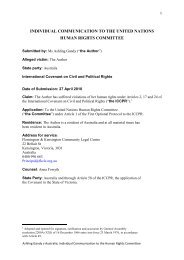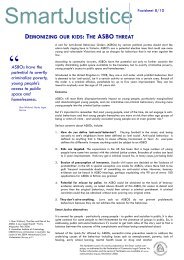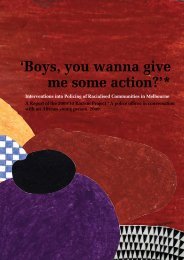Reducing Ethnic Profiling in the European Union - Open Society ...
Reducing Ethnic Profiling in the European Union - Open Society ...
Reducing Ethnic Profiling in the European Union - Open Society ...
- No tags were found...
Create successful ePaper yourself
Turn your PDF publications into a flip-book with our unique Google optimized e-Paper software.
139. For example, <strong>European</strong> Commission Aga<strong>in</strong>st Racism and Intolerance, Third Report Germany,Strasbourg: ECRI, 2003, at 85; and <strong>the</strong> OSCE, Recommendations on Polic<strong>in</strong>g <strong>in</strong> Multi-<strong>Ethnic</strong> Societies.See also, Fundamental Rights Agency, Toward More Effective Polic<strong>in</strong>g. Understand<strong>in</strong>g and Prevent<strong>in</strong>gDiscrim<strong>in</strong>atory <strong>Ethnic</strong> <strong>Profil<strong>in</strong>g</strong>: A Guide, Vienna: FRA, 2010, at 25.140. Article 42.141. The basic pr<strong>in</strong>ciples of data protection <strong>in</strong> <strong>the</strong> police sector are established <strong>in</strong> <strong>the</strong> Councilof Europe’s Recommendation 15 of 1987 on <strong>the</strong> use of personal data <strong>in</strong> <strong>the</strong> police sector. Fur<strong>the</strong>rguidance is provided by <strong>the</strong> Council of Europe’s Convention for <strong>the</strong> Protection of Individuals withRegard to Automatic Process<strong>in</strong>g of Personal Data (1981).142. Council of Europe Convention for <strong>the</strong> Protection of Individuals with Regard to AutomaticProcess<strong>in</strong>g of Personal Data (1981) Article 6 on special categories of data.143. Recommendation 15 (1987) stipulates that “Measures should be taken so that personal datakept for police purposes are deleted if <strong>the</strong>y are no longer necessary for <strong>the</strong> purposes for which <strong>the</strong>ywere stored.”144. New York State Assembly law A.11177-A/S.7945-A.145. Section 95 of <strong>the</strong> 1991 Crim<strong>in</strong>al Justice Act.146. In <strong>the</strong> United K<strong>in</strong>gdom, stop data are often compared aga<strong>in</strong>st census data which gives <strong>the</strong>resident population of a given area at a po<strong>in</strong>t <strong>in</strong> time. As <strong>the</strong>re can be long <strong>in</strong>tervals between onecensus and ano<strong>the</strong>r, census data may not provide an up-to-date representation of local resident populations.There are also circumstances <strong>in</strong> which census data on residents may not reflect <strong>the</strong> profileof people who are actually present <strong>in</strong> a particular place at a particular time. For example, <strong>the</strong> localcensus is unlikely to provide an accurate picture of persons driv<strong>in</strong>g on motorways or us<strong>in</strong>g publicspaces. It also appears that <strong>the</strong> police conduct stops and searches <strong>in</strong> places and at times when largenumbers of young people and ethnic m<strong>in</strong>orities are present. The factors outl<strong>in</strong>ed above lay beh<strong>in</strong>da pioneer<strong>in</strong>g observational study <strong>in</strong> <strong>the</strong> United K<strong>in</strong>gdom.147. Nick Bland, Joel Miller, et al, Upp<strong>in</strong>g <strong>the</strong> PACE? An evaluation of <strong>the</strong> recommendations of <strong>the</strong>Stephen Lawrence Inquiry on stops and searches, London: Home Office, 2000.148. Case study based on <strong>in</strong>terviews conducted with <strong>the</strong> Merseyside Police <strong>in</strong> March 2011.149. StopWatch, StopWatch’s response to <strong>the</strong> proposed changes to <strong>the</strong> Police and Crim<strong>in</strong>al Evidence Act1984 (PACE) Code of Practice A. Revisions proposed 20th September 2010, London: October 2010. The<strong>Open</strong> <strong>Society</strong> Justice Initiative is a found<strong>in</strong>g member of StopWatch. See www.stop-watch.org.150. Case study based on <strong>in</strong>terviews with <strong>the</strong> West Yorkshire Police <strong>in</strong> June 2010.151. In Spa<strong>in</strong>, nationality was used a proxy for ethnicity. Thus <strong>the</strong> term “Spanish” is used to <strong>in</strong>dicate“white Spanish,” while nationality is used to described <strong>the</strong> ethnicity of o<strong>the</strong>r groups stopped.As few immigrants to Spa<strong>in</strong> have nationalized, it is still possible to use nationality as an accurateproxy for ethnicity, but this but this hides those who have nationalized, ethnic m<strong>in</strong>orities who areborn <strong>in</strong> Spa<strong>in</strong>, and Roma, and will cease to be a useful proxy over time.152. See <strong>Open</strong> <strong>Society</strong> Justice Initiative, Address<strong>in</strong>g <strong>Ethnic</strong> <strong>Profil<strong>in</strong>g</strong> by <strong>the</strong> Police: A Report on <strong>the</strong>Strategies for Effective Police Stop and Search (STEPSS) Project, New York: OSI, 2008. A STEPSSResource Pack conta<strong>in</strong><strong>in</strong>g examples of forms, operational guidance and “know your rights” bookletsis available on request from: <strong>in</strong>fo@justice<strong>in</strong>itiative.org.REDUCING ETHNIC PROFILING IN THE EUROPEAN UNION 217
















